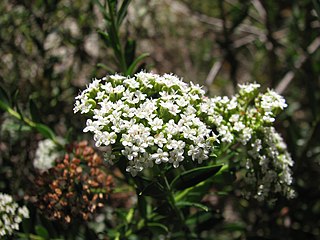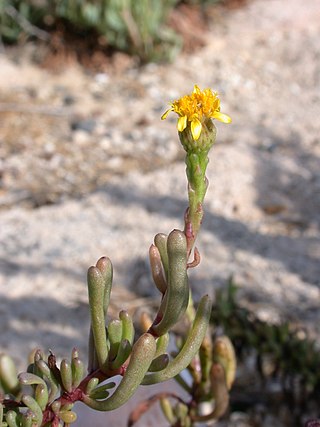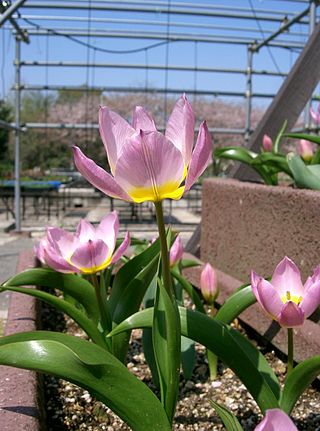
Willows, also called sallows and osiers, of the genus Salix, comprise around 350 species of typically deciduous trees and shrubs, found primarily on moist soils in cold and temperate regions.

Myrtaceae, the myrtle family, is a family of dicotyledonous plants placed within the order Myrtales. Myrtle, pōhutukawa, bay rum tree, clove, guava, acca (feijoa), allspice, and eucalyptus are some notable members of this group. All species are woody, contain essential oils, and have flower parts in multiples of four or five. The leaves are evergreen, alternate to mostly opposite, simple, and usually entire. The flowers have a base number of five petals, though in several genera, the petals are minute or absent. The stamens are usually very conspicuous, brightly coloured, and numerous.

Inula is a genus of about 80 species of flowering plants in the family Asteraceae, native to Europe, Asia and Africa.
Adenocline is a genus of plants, under the family Euphorbiaceae first described as a genus in 1843. It is native to southern Africa.
- Adenocline acuta(Thunb.) Baill. - Malawi, Zimbabwe, Cape Province
- Adenocline paucifloraTurcz. - KwaZulu-Natal, Cape Province
- Adenocline violifolia(Kunze) Prain - Cape Province
Ampelocalamus is a genus of Asian bamboo in the grass family). It is found mostly in Southern China, with some species in the eastern Himalayas and northern Indochina.

Platysace is a genus of woody perennial herbs and subshrubs in the family Apiaceae. The genus is endemic to Australia.
Triptilodiscus is a genus of flowering plants in the tribe Gnaphalieae within the family Asteraceae.
Endocellion is a small genus of flowering plants in the daisy family Asteraceae.

Limbarda is a genus of succulent, xerophytic plants in the daisy family.

Ceratogyne is a genus of flowering plants in the family Asteraceae.

Tulipa saxatilis is a Greek and Turkish species of plant in the genus Tulipa of the family Liliaceae.
Pericalymma is a group of plants in the myrtle family Myrtaceae described as a genus in 1840. The entire genus is endemic to Western Australia.
- Pericalymma crassipes(Lehm.) Schauer
- Pericalymma ellipticum(Endl.) Schauer
- Pericalymma megaphyllumCranfield
- Pericalymma spongiocauleCranfield

Fritillaria dagana is a rare bulbous herbaceous perennial plant native to Siberia, Russia. It is a species in the genus Fritillaria of the family Liliaceae. It is placed in the subgenus Liliorhiza.

Salix repens, the creeping willow, is a small, shrubby species of willow in the family Salicaceae, growing up to 1.5 metres in height. Found amongst sand dunes and heathlands, it is a polymorphic species, with a wide range of variants. In the UK, at least, these range from small, prostrate, hairless plants at one end of the spectrum to taller, erect or ascending silky-leaved shrubs at the other. This wide variation in form has resulted in numerous synonyms.

Salix waldsteiniana, the Waldstein willow, is a species of willow native to Europe.

Salix kirilowiana is a willow species described by Sergei Sergeyevich Sheglejev. Salix kirilowiana is part of the genus Salix, and the family Salicaceae. No subspecies are listed in the Catalog of Life.
Salix nuristanica is a species of willow which was described by A.K.Skvortsov in 1965.
Salix athabascensis is a species of willow first described by Hugh Miller Raup.
Salix pantosericea is a species of willow first described by Görz in 1934 from the Caucasus region.











